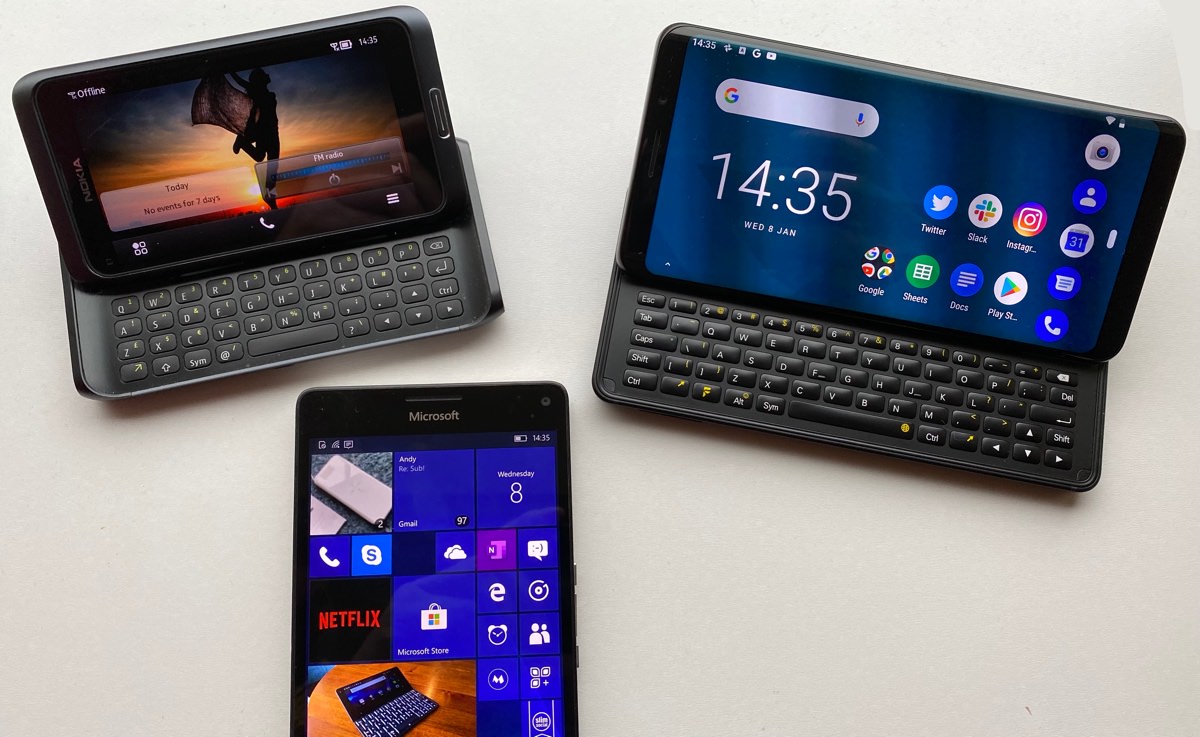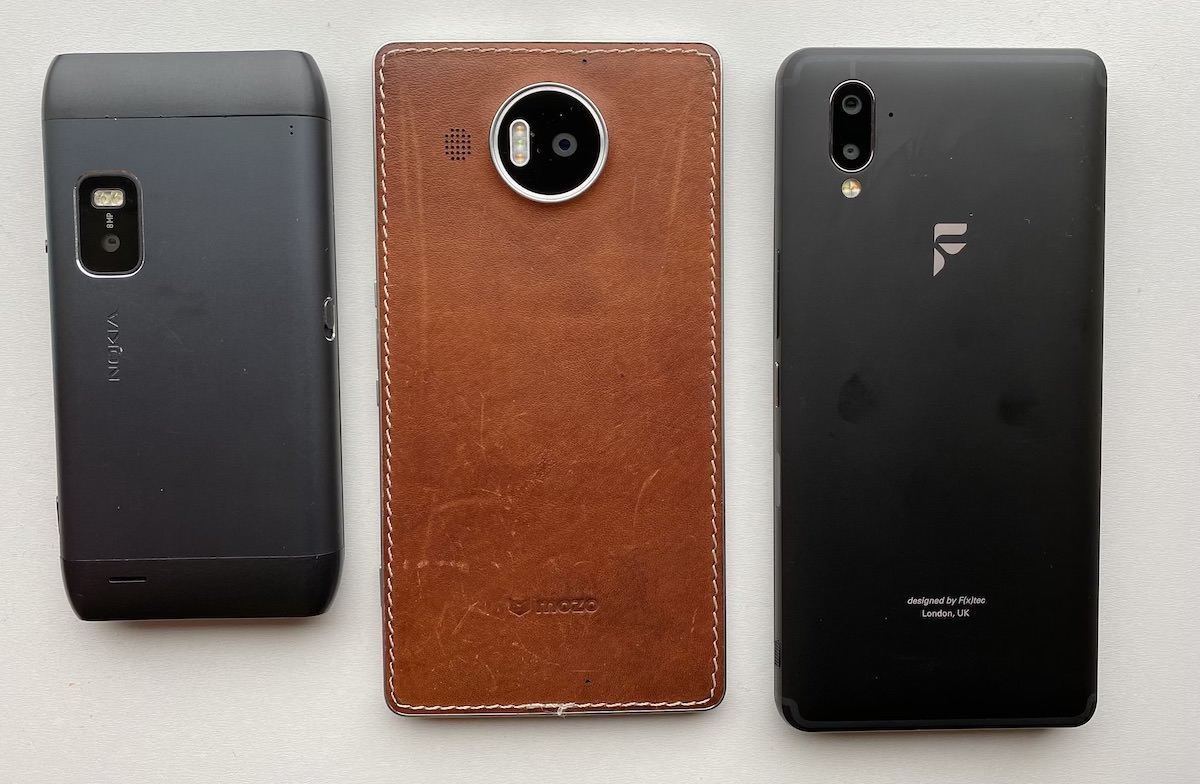
For size comparison, the 2010 Nokia E7 and the 2020 f(x)tec Pro1 (with part of a Lumia 950 XL in the foreground). The E7 and Pro1 keys are about the same size, though the latter has extra punctuation and control keys either side. In practice, the Pro1 keyboard is more of a stretch for thumbs from the device sides, as a result. The layout is also staggered rather than in grid form, but muscle memory will develop with either.
Although there's a little life left in Windows 10 Mobile in terms of updates and support, new hardware is non-existent, plus repairs and spares for older hardware are heading the same way - so it makes sense for everyone to be aware of the best of the rest from other platforms. And this new niche handset/palmtop from f(x)tec is especially interesting to the old 'Communicator' crowd from the Symbian world, which is why there's a Nokia E7 in the photo too, for comparison!

Left to right, from the back, Nokia E7, Lumia 950 XL (with Mozo back), f(x)tec Pro1... Anyone else remember when the E7 was the biggest smartphone in the Symbian world and one of the biggest in the phone world, period? It's now dwarfed by everything!
So, back to the specs, and using the 950 XL as a data point here on AAWP (again, the E7 is too far back in time for specs to make sense). As usual, I've shaded in green an obvious 'win' for either device. Any row where a winner would be totally subjective is left uncoloured. Or, where all devices are utterly excellent but in different ways, I've given each a 'green'(!)
[By the way, if you're viewing this feature on a phone then the table may well cause you problems. Try viewing in landscape mode? Failing that, go view this on a laptop or tablet!]
| Microsoft Lumia 950 XL | f(x)tec Pro1 | |
| Date first available | November 2015 | January 2020 (first retail samples available) |
| Current price, availability | No longer officially for sale, though it's often on clearance prices if you're lucky and at outrageous profiteering prices due to rarity (if you're not!) | £649 from f(x)tec. Not too outrageous in the world of 2020 for a specialised handset, I feel. |
| Dimensions, form factor, weight |
152 x 78 x 8mm, plastic chassis and replaceable backs (plastic/leather/wood etc, from Mozo, as modelled here!), 165g, bezels are comparatively small |
154 x 74 x 14mm, 245g, metal-backed top screen half and all metal bottom half. Very heavy, but the keyboard is the reason for this, so understandable. The 14mm thickness seems a problem, but the curved styling on every corner does mean that it's gentle on the hand. |
| Durability | No specific durability metrics, though the fact that the back comes off will help enormously for water damage, i.e. taking out battery and cards immediately, drying out the internals, even unscrewing the motherboard from the guts of the phone. I'm old-school here! All damage to the back or corners is trivial through replacement of the rear, but the screen's exposed, of course. The plastics used should absorb shock and, anecdotally, I've never bothered putting a case on any Lumia. Just saying. I think that fact is significant. |
No durability rating, for obvious reasons. Although the metal chassis and mechanism are quite strong, water and dust will get in everywhere - so you'd have to be very careful! |
| Operating system, interface | Windows 10 Mobile, (dismissable) virtual controls, as needed, now officially updated to W10 Fall Creators Update (Redstone 3, Autumn 2017) with security to 'October 2019'. |
Android 9, September 2019 security, gesture controls from bottom 'pill' with variable back control. Full five row QWERTY keyboard give extra options in terms of text entry without using up screen real estate. |
| Display |
5.7" AMOLED (1440p at 16:9 aspect ratio, matching most video media), Gorilla Glass 4, ClearBlack Display polarisers help with outdoor contrast, excellent viewing angles. Screen area is approximately 88 cm2 Glance screen available (in various colours) for always-on time, day and notification icons, plus some detailed info from a specified app, give the Lumia the win here. |
5.9" 1080p AMOLED, 18:9 ratio, Gorilla Glass 3, screen area is roughly 100cm2 No Glance/always-on system available. |
| Connectivity |
LTE, NFC (all uses), Wi-Fi b/g/n/ac, integral wifi tethering, Bluetooth 4.2 (all uses). Continuum connectivity to use a wide range of first and third party UWP apps on external displays as secondary screen, independent of the phone display. Includes the new NexDock 2, transforming the Lumia into a Windows 10 S laptop, effectively. |
LTE, NFC (all uses), Wi-Fi b/g/n/ac, integral wifi tethering, Bluetooth 5.0 (all uses). HDMI out over Type C for screen mirroring. |
| Processor, performance | Snapdragon 810 chipset, 3GB RAM, faster than it's ever been now on the Fall Creators Update though still slower for almost everything than on the Android phone. Multi tasking and app resumption is excellent though, at least with all the modern UWP apps |
Snapdragon 835, 6GB RAM, pretty fast at everything compared to the Lumia, though not as snappy as the current Android flagships. |
| Capacity | 32GB internal storage, expandable via (cheap) microSD to extra 256GB | 128GB internal storage, plus microSD support if you don't need the second nano-SIM slot. |
| Imaging (stills) |
20MP PureView f/1.9 1/2.4" BSI sensor, Phase Detection auto-focus, dedicated camera shutter button and launch key, genuine 2x lossless digital zoom (in 8MP oversampled mode), OIS. 'Rich Capture' produces customisable HDR shots and 'dynamic flash', with triple LED illumination. Outstanding shots in most light conditions, with just focussing issues in low light as an Achilles heel. 5MP front camera, no auto-focus |
12MP, f/1.8, PDAF, dedicated camera launch button Camera interface has 'lag' plus is currently immature in terms of features. 8MP, f/2.0 front camera, no auto-focus |
| Imaging (video) | Up to 4K, optically (and optionally digitally) stabilised, with 'Best photo' 8MP grabbing built-in, plus Rich Recording and HAAC microphones for high quality, gig-level stereo capture. | Up to 4K video capture, with EIS, high quality stereo audio capture. |
| Music and Multimedia (speakers) |
A tinny mono speaker by modern standards, though as ever you can trade volume for fidelity in a simple tweak on Lumias. | Stereo speakers, matched components, these work pretty well, though fidelity isn't the best in the phone world (iPhone 11 series and Samsung Galaxies are better, for example). |
| Music (headphones) |
3.5mm headphone jack, A2DP+AptX, so great wired and wireless headphone audio too. | 3.5mm headphone jack with very punchy, loud output - a notch above the Lumia's. Plus the usual A2DP for Bluetooth audio. |
| Navigation |
Windows 10 Maps is now pretty mature and impressive, especially once you've learned the live traffic routine trick! Offline maps save a lot of data bandwidth for those on tight contracts or anyone in a low signal (data) area, and these get the win here. |
Google Maps is now the gold standard in phone navigation, tied in with many other Google services and offering true real time navigation around traffic issues, along with offline maps that auto-update. |
| Cortana/Voice | Cortana is now mature and well integrated, though some functionality has been falling away, e.g. recognising ambient music, plus there are reliability concerns under Windows 10 Mobile. | Google Assistant is baked in and works well (activated from the lockscreen or via voice), far superior to Cortana in 2020, due to the investment that Google has put in over the last few years. |
| Battery, life | Removable 3000mAh battery, and the ability to change cells gets the win here, plus USB Type C Power Delivery (up to 3A, so 15W) and 1A Qi wireless charging built-in also helps enormously. However, a Lumia running Windows 10 Mobile will now discharge in 24 hours even if you don't use it much. |
Sealed 3200mAh battery, gets through a day, though depends on the use case for the phone. Type C port supports QuickCharge 3.0, so 9V at 2A (18W) for fast charging. |
| Cloud aids | Windows Photos syncs across all signed-in devices, subject to your OneDrive tariff (stingy, unless you have Office 365), should you have thousands of images in the system. Plus Windows 10 backs all your media, application data and settings to a separate backup folder system, tariff-free on OneDrive, for easy restoration on a new or factory reset phone. | Google Photos does a great job of organising photos and syncing them across all signed-in phones and tablets, albeit at 'reduced' quality (re-compression server-side). |
| File compatibility | As with all Windows phones, plugging into a Windows PC gives full drag and drop to the phone's user file system. Plugging into a Mac sadly isn't possible anymore. | Plugging into a PC gives immediate MTP file access, plus this works well on a Mac with Google's Android File Transfer utility, for drag and drop of all user files. |
| Biometrics | Iris recognition ('Windows Hello') works well unless you wear varifocals(!), but takes a couple of seconds (including an animation!) in real world use. There's also no official way of paying in shops using this, at least not in most of the world. |
Capacitive fingerprint scanner on the right hand side works well enough, though it's about a second from touching this to authentication and the screen being powered on. Also, the sensor is different to the power button, which is confusing. All compatible with Google Pay though. |
| Applications and ecosystem | Windows 10 Mobile has most (though not all) mainstream apps and services covered. Often third party clients are involved, mind you, there are companies who hate Microsoft so much that they simply refuse to write for Windows, it seems. And 'long tail' niche/boutique apps are hard to find for real world companies and shops. |
The might of Google and Android's app ecosystem - everything is available and almost always in first party form. |
| Upgrades and future | Windows 10 Mobile is now effectively out of support. From now on, it will be useable but with more and more service caveats applying. Still, 'end 2019' was a full four years since the Lumia 950 XL was launched, so it's hard to complain. | f(x)tec is a small company with limited resources, but I believe it can get updates out in 2020, I'd bet on Android 10 arriving in the late Spring. |
Verdict
Adding up the green 'wins' (for fun?!) gives a 10-6 win to the much newer device, though in this case the form factors and use cases are so different that the scoring is somewhat irrelevant. Whereas you'd buy the Lumia (back in the day) for its camera system, you buy the Pro1 for the same reason why people bought the Nokia E7 back in the day - an always available flip-out QWERTY keyboard.
Your comments welcome.
PS. See also my video review of the Pro1
